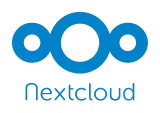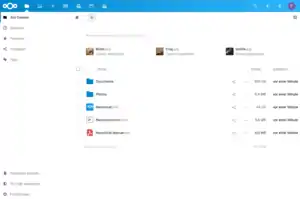Nextcloud
Nextcloud is a suite of client-server software for creating and using file hosting services. Nextcloud is free and open-source, which means that anyone is allowed to install and operate it on their own private server devices.
 | |
 | |
| Developer(s) | Nextcloud GmbH.,[1] Community |
|---|---|
| Stable release | |
| Repository | |
| Written in | PHP, JavaScript |
| Operating system | Server: Linux Clients: Windows, macOS, Linux, Android, iOS |
| Type | Online storage, data synchronization |
| Licence | AGPLv3+ |
| Website | nextcloud |
With the integrated OnlyOffice, Nextcloud is functionally similar to Dropbox, Office 365 or Google Drive, but can be used on home-local computers or for off-premises file storage hosting.
The original ownCloud developer Frank Karlitschek forked ownCloud and created Nextcloud, which continues to be actively developed by Karlitschek and other members of the original ownCloud team.
Features
Nextcloud files are stored in conventional directory structures, accessible via WebDAV if necessary. User files are encrypted during transit and optionally at rest. Nextcloud can synchronise with local clients running Windows (Windows 7, 8, and 10),[8] macOS (10.6 or later), or various Linux distributions.
Nextcloud permits user and group administration (via OpenID or LDAP). Content can be shared by defining granular read/write permissions between users and groups. Alternatively, Nextcloud users can create public URLs when sharing files. Logging of file-related actions, as well as disallowing access based on file access rules is also available.[9]
Nextcloud has planned new features such as monitoring capabilities, full-text search and Kerberos authentication, as well as audio/video conferencing, expanded federation and smaller user interface improvements.[10]
Since the software is modular, it can be extended with plugins to implement extra functionality. Developers can offer their extensions to other users for installation via a manufacturer-operated platform. This platform communicates with the Nextcloud instances via an open protocol. The App Store[11] contains over 200 extensions. With the help of these extensions, many functionalities can be added, including:
- calendars (CalDAV)
- contacts (CardDAV)
- streaming media (Ampache)
- browser-based text editor
- bookmarking service
- URL shortening suite
- gallery
- RSS feed reader
- document viewer tools from within Nextcloud
- connection to Dropbox, Google Drive and Amazon S3
- Web analytics (Use of Matomo (software))
- Integration of Content management systems e.g. Pico CMS
- Viewer for Weather forecasting
- Viewer for DICOM
- Viewer for Maps
- Managing of Cooking recipes
On January 17, 2020, version 18 was presented in Berlin under the product name Nextcloud Hub. For the first time, an office package (here OnlyOffice) was directly integrated here and Nextcloud announced as its goal direct competition with Microsoft Office 365 and Google Docs. Furthermore, a partnership with Ionos was announced at this date. Office functionality is limited to x86/x64 based servers as OnlyOffice does not support ARM processors. In contrast to proprietary services the open architecture enables users to have full control of their data.
Architecture
In order for desktop machines to synchronize files with their Nextcloud server, desktop clients are available for PCs running Windows, macOS, FreeBSD or Linux. Mobile clients exist for iOS and Android devices. Files and other data (such as calendars, contacts or bookmarks) can also be accessed, managed, and uploaded using a web browser without any additional software. Any updates to the file system are pushed to all computers and mobile devices connected to a user's account.
The Nextcloud server is written in the PHP and JavaScript scripting languages. For remote access, it employs sabre/dav, an open-source WebDAV server.[12] Nextcloud is designed to work with several database management systems, including SQLite, MariaDB, MySQL, Oracle Database, and PostgreSQL.[13]
With Nextcloud 12, a new architecture was developed with the name Global Scale, with the goal of scaling to hundreds of millions of users. It splits users over separate nodes and introduces components to manage the interaction between them.[14]
Nextcloud Box

In September 2016, Nextcloud, in cooperation with Western Digital Labs and Canonical (the company behind Ubuntu), released the Nextcloud Box.[15] The Nextcloud box was based on a Raspberry Pi, running Ubuntu Core with Snappy; it was intended to serve as a reference device for other vendors.[16] In June 2017, Western Digital shut down Western Digital Labs,[17] which caused the production of the box to end.[18]
History of the fork from ownCloud
In April 2016 Karlitschek and most core contributors [19] left ownCloud Inc.[20] These included some of ownCloud's staff according to sources near to the ownCloud community.[21]
The fork was preceded by a blog post of Karlitschek, asking questions such as "Who owns the community? Who owns ownCloud itself? And what matters more, short term money or long term responsibility and growth?"[20] There have been no official statements about the reason for the fork. However, Karlitschek mentioned the fork several times in a talk at the 2018 FOSDEM conference, emphasizing cultural mismatch between open source developers and business oriented people not used to the open source community.[22]
On June 2, within 12 hours of the announcement of the fork, the American entity "ownCloud Inc." announced that it is shutting down with immediate effect, stating that "[…] main lenders in the US have cancelled our credit. Following American law, we are forced to close the doors of ownCloud, Inc. with immediate effect and terminate the contracts of 8 employees.". ownCloud Inc. accused Karlitschek of poaching developers, while Nextcloud developers such as Arthur Schiwon stated that he "decided to quit because not everything in the ownCloud Inc. company world evolved as I imagined".[23] ownCloud GmbH continued operations, secured financing from new investors and took over the business of the ownCloud Inc.[24]
Differences from ownCloud
While Nextcloud was originally a fork of the ownCloud project, there are now many differences. For instance, ownCloud offers an open-source community edition, but also offers a proprietary Enterprise Edition with additional features and supports subscriptions—Nextcloud instead uses the same public code base for both free and paid users.
Release history
| Version | Original release date | Latest version | Release date | Major features |
|---|---|---|---|---|
| 9 | June 14, 2016[25] | 9.0.58 | 2017-04-24[26] | |
| 10 | August 25, 2016[27] | 10.0.6 | 2017-08-07[26] | |
| 11 | December 13, 2016[28] | 11.0.8 | 2018-03-15[26] | |
| 12 | May 22, 2017[29] | 12.0.13 | 2018-11-22[26] | |
| 13 | February 6, 2018[30] | 13.0.12 | 2019-02-29[26] |
|
| 14 | September 10, 2018[31] | 14.0.14 | 2019-08-16[26] | |
| 15 | December 10, 2018[32] | 15.0.14 | 2019-12-19[26] | |
| 16 | April 25, 2019 | 16.0.11 | 2020-06-04[26] |
|
| 17 | September 30, 2019 | 17.0.10 | 2020-10-08[26] |
|
| 18 | January 17, 2020 | 18.0.14 | 2021-01-27[26] |
|
| 19 | June 3, 2020 | 19.0.8 | 2021-01-27[26] | Features |
| 20 | October 3, 2020 | 20.0.7 | 2021-02-03[26] | Features
|
| 21 | February 22, 2021[38] | 21.0.0 | ||
Legend: Old version Older version, still maintained Latest version Future release | ||||
Maintenance and release schedule[39]
See also
- Seafile (FOSS client-server software for file storage and transfer)
- Comparison of file hosting services
- Comparison of file synchronization software
- Comparison of online backup services
References
- "Official Company Website".
- "Nextcloud Server Changelog". Retrieved 2020-02-13.
- "Changelog of Android-App at Github". Retrieved 2021-01-15.
- "Play store site for Android". Google Play. Retrieved 2021-01-15.
- "Changelog of iOS app at Github". Retrieved 2020-09-25.
- "App Store site for iOS". App Store (iOS). Retrieved 2020-09-25.
- "Changelog of Nextcloud desktop client". Retrieved 2021-01-15.
- https://docs.nextcloud.com/desktop/2.3/installing.html#system-requirements
- "File Access Control – A firewall for your private files in Nextcloud". 25 August 2016. Retrieved 22 September 2016.
- Steven J. Vaughan-Nichols (14 December 2016). "Nextcloud adds security and scalability to its private cloud offering". ZDNet. Retrieved 19 January 2017.
- "Nextcloud App Store".
- "ownCloud and sabre/dav". owncloud.org. Retrieved 22 September 2016.
- "Database Configuration - Nextcloud 12 Server Administration Manual 12 documentation".
- "Nextcloud announces Global Scale architecture as part of Nextcloud 12". nextcloud.com. Retrieved 14 June 2017.
- "Nextcloud Box – a private cloud and IoT solution for home users – from Nextcloud, Canonical and WDLabs Box". Nextcloud. 16 September 2016. Archived from the original on 24 September 2016. Retrieved 22 September 2016.
- Swapnil Bhartiya (16 September 2016). "Everything you need to know about Nextcloud Box". CIO.com. Retrieved 22 September 2016.
- Kevin Parrish (22 June 2017). "Source confirms Western Digital is closing WDLabs and canceling projects". Digital Trends. Retrieved 5 October 2018.
- "Nextcloud box updates: Raspberry Pi 3, Nextcloud 12 and looking for a new provider". Nextcloud. 4 August 2017. Retrieved 5 October 2018.
- Github (1 June 2016). "Contribution overview to Nextcloud Server". Retrieved 2 April 2019.
- Frank Karlitschek (27 April 2016). "big changes: I am leaving ownCloud, Inc. today". blog. Retrieved 22 September 2016.
- Steven J. Vaughan-Nichols (2 June 2016). "OwnCloud founder forks popular open-source cloud". ZDNET. Retrieved 22 September 2016.
- Frank Karlitschek (4 February 2018). "Why I forked my own project and my own company".
- Swapnil Bhartiya (6 June 2016). "What we can learn from ownCloud's collapse". CIO.com. Retrieved 22 September 2016.
- "ownCloud Secures Financing and Expands its Management Team - ownCloud". 14 July 2016.
- "Nextcloud 9 Available, Enterprise Functionality to be Open Source". Retrieved 2018-09-10.
- Maintenance and Release Schedule, Nextcloud, 2020-05-27, retrieved 2019-12-05
- "Secure, Monitor and Control your data with Nextcloud 10 – get it now!". Retrieved 2018-09-10.
- "Nextcloud 11 sets new standard for security and scalability". Retrieved 2018-09-10.
- "Welcome to Nextcloud 12!". Retrieved 2018-09-10.
- "Nextcloud 13 Brings Improved UI, Video and Text Chat, End-to-end Encryption, Improved performance and more". Retrieved 2018-09-10.
- "Nextcloud 14 now available with Video Verification, Signal/Telegram 2FA support, Improved Collaboration and GDPR compliance". Retrieved 2018-09-10.
- "Nextcloud 15 goes social, enforces TFA and gives you a new generation real-time document editing". Retrieved 2018-12-10.
- "Nextcloud 16 implements Access Control Lists to replace classic File Servers". 2019-04-25.
- "Nextcloud 16 introduces machine learning based security and usability features, ACL permissions and cross-app projects". 2019-04-25.
- "Nextcloud 16 allows you to link resources to keep track of your projects". 2019-04-25.
- "Talk 6 brings Commands, improved user experience and more". 2019-04-25.
- Nextcloud. "The new standard in on-premises team collaboration: Nextcloud Hub". Nextcloud. Retrieved 2020-01-22.
- "Maintenance and Release Schedule".
- Maintenance and Release Schedule, Nextcloud, 2019-11-13, retrieved 2019-12-05
